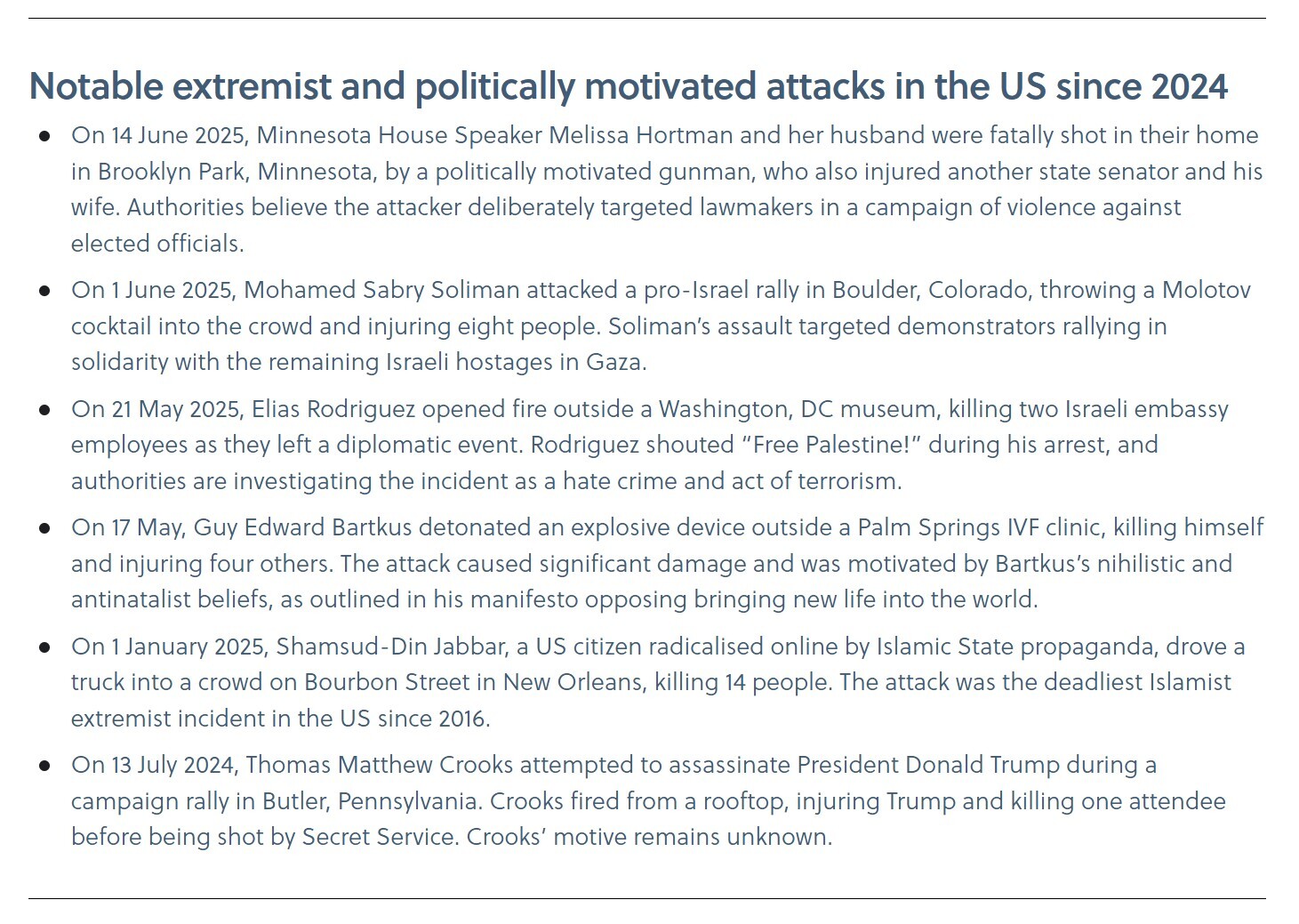Dangerous divides: The evolving threat of extremism in the US
Over the past year, the US has experienced a rise in extremist violence spanning a wide spectrum of ideologies and grievances. On 22 May, a gunman fatally shot two Israeli embassy employees in Washington, DC, in an attack linked to tensions over the conflict in Gaza. The attack forms part of a series of incidents that includes the attempted assassination of former President Donald Trump in July 2024, an Islamic State-inspired vehicle-ramming attack that killed 15 people in New Orleans in January, and the assassination of Minnesota House Speaker Melissa Hortman and her husband last month. The range of perpetrators and targets underscores the volatility of the current threat environment – what FBI Director Christopher Wray in 2024 described as an unprecedented moment, when “so many of the threats are all elevated all at exactly the same time.” With motivations rooted in both international and domestic dynamics, extremist actors are exploiting this increasingly fractured landscape, posing growing challenges for US authorities.

A fractured landscape
The broad spectrum of threats facing the US stems from several converging factors. First, the country has become increasingly polarised. According to recent Gallup data, the US is more divided now than at any point in the past 30 years, with 80 percent of Americans believing the nation is deeply split over its most important values. In addition, domestic disputes over election outcomes, societal tensions, and policy disagreements – particularly on issues such as immigration, race, and the economy – have become more confrontational, especially among supporters of the two major political parties, the Democrats and the Republicans.
These internal divisions are being compounded by a climate of global instability and by domestic responses to contentious international issue.
Over the past two years, the Israel-Palestine conflict has had a particularly profound impact, with significant segments of the population taking opposing sides – often resulting in open hostility. These divides have been further amplified by the spread of online disinformation and misinformation. Social media platforms have increasingly become tools for inflaming tensions, exploited by a range of actors including transnational Islamist militant groups, political extremists, and even state-linked entities from countries like Russia and Iran – all contributing to a more volatile domestic environment.
Extremism in action
With tensions deepening across social, political, and ideological lines, various forms of extremism have emerged as key concerns for US security, the most prominent of which include hate crimes and identity-based violence, Islamist-inspired attacks, and politically motivated violence, including threats and attacks against public officials.
- Hate crimes and identity-based violence: Perpetrators have targeted victims with physical violence, as well as acts of sabotage and damage to commercial properties and religious sites. In 2023, the Council on American-Islamic Relations reported a 56 percent increase in cases of anti-Muslim discrimination and bias. Similarly, between October 2023 and January 2024, the Anti-Defamation League, an anti-discrimination NGO, recorded a 360 percent surge in antisemitic incidents compared to the same period the previous year. In one recent example, two Israeli tourists were injured when a gunman opened fire on them in Miami Beach, Florida. The attacker, a Jewish US citizen, reportedly mistook the tourists for Palestinians. Similarly, over the past year, multiple Jewish-owned businesses in states such as New York, California, and Massachusetts have reported incidents of vandalism and sabotage, which police are investigating as potential hate crimes.
- Islamist extremists: Islamist-inspired actors continue to pose a significant security threat to the US. Although the likelihood of large-scale, sophisticated mass-casualty attacks by transnational groups such as Al Qaeda has diminished considerably – largely due to improved intelligence and law enforcement capabilities – the risk of attacks using rudimentary methods by self-radicalised individuals or small groups remains. While both Al Qaeda and the Islamic State (IS) have limited capacity to conduct direct operations within the US, IS in particular maintains an active online presence and has sought to exploit the Israel-Palestine conflict by encouraging ‘lone wolf’ supporters to target Jewish, Israeli, and US interests, the most notable recent example being the January attack in New Orleans.
- Politically motivated violence: Targeted attacks on elected officials and political candidates have increased significantly in recent years. According to the US Capitol Police, the number of concerning statements and direct threats made against members of Congress more than doubled between 2017 and 2024. Additionally, extremist violence has increasingly targeted businesspeople and companies due to their perceived connections with high-profile political figures and their political affiliations. In most cases, the perpetrators have been lone actors, as seen in both the attempted assassination of President Trump and the killing of Melissa Hortman and her husband. These factors present significant challenges to efforts aimed at anticipating and preventing such attacks.
Looking ahead
These threats present a formidable test for US law enforcement and policymakers alike. As extremist actors draw energy from both global instability and persistent domestic fractures, the task of anticipating and preventing attacks grows ever more complex. The decentralised and often unpredictable nature of today’s threats means that agencies must contend with a steady stream of ideologically diverse risks, many of which can escalate rapidly and with little warning. Consequently, amid this volatile and uncertain environment, the extremist threat in the US is likely to persist for the foreseeable future.
